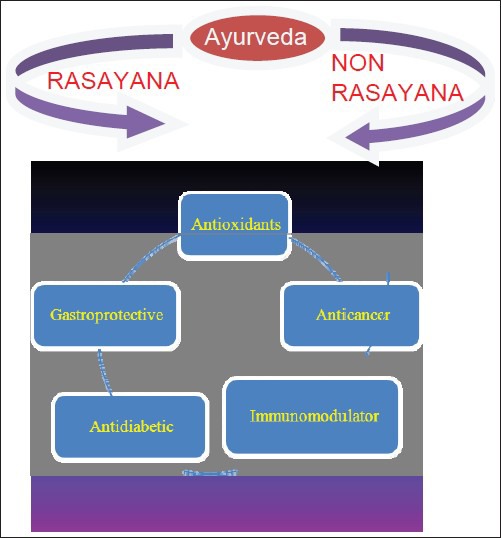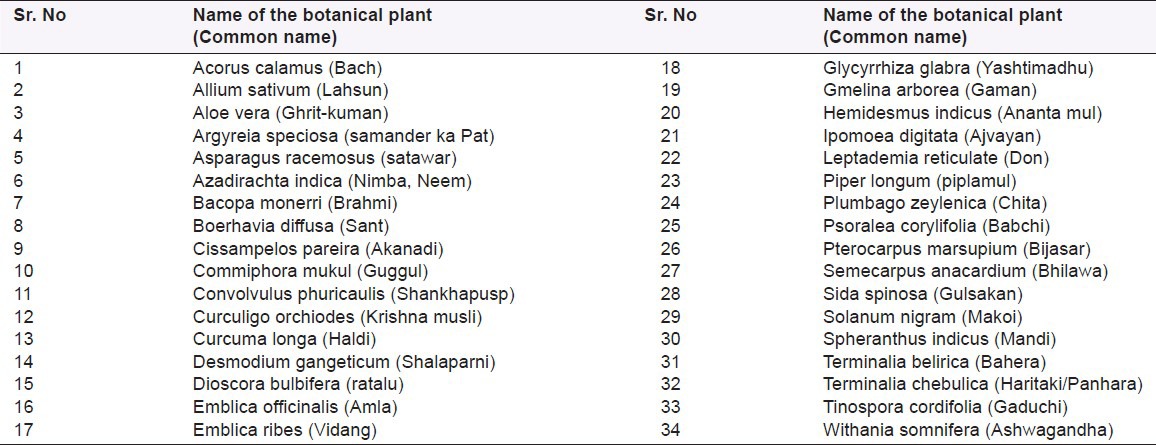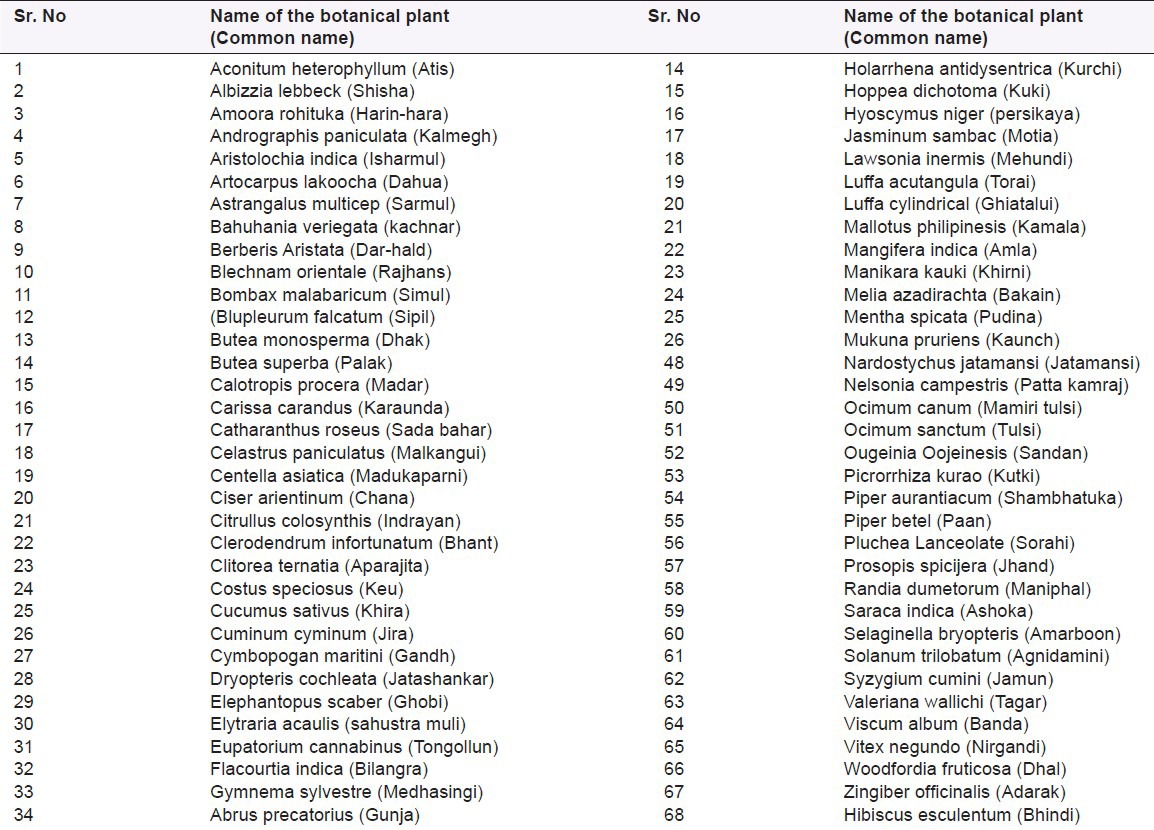Abstract
Ayurvedic therapeutics describes vast number of medicinal herbs used as “Vyadhirodhak Chamatav” that has enlightened the application of herbs used as corner stone in various diseases especially those modulating the immune system. Ayurveda literature comprises of rasayana and non-rasayana herbs. Materia Medica entirely enriched with enormous data of rasayana medicinal herbs acting as immunomodulators in existence. However, as such there is no specific review of literature available for non-Rasayana herbs that have immense potential as immunomodulators. This review article empowers data on non-rasayana medicinal herbs as promising future target for immunotherapy.
Keywords: Active, cellular, humoral, innate, immunization, passive
INTRODUCTION
Medicinal herbs
Importance of medicinal herbs
According to World Health Organization more than 75% of the population relies on herbs used as traditional remedies for primary health-care.[1] Medicinal herbs are a potential source of therapeutic aids and have gained significant importance in the health-care system all over the world for both humans and animals in diseased conditions and to maintain proper health.[2] Indian herbal industries with considerable research in the field of pharmacognosy, phytochemistry, pharmacology and clinical therapeutics have explored these ayurvedic herbs, which are now designed into numerous herbal formulations, which have entered the international pharmacopeia through the study of ethnopharmacology and traditional medicine.[3]
Thus, the surge in research on drugs from a natural source is now moving from herbalists shop away from the core texts into drug research laboratories, hence remarkable research on various fields of pharmaceutical sciences utilizing ayurvedic literature has helped Indian herbal industries to expand annually at 20% growth rate every year.[4,5,6]
Importance of immunoherbs
Herbs, which influence any constituents or function of the immune system in a specific or non-specific manner including both innate and adaptive arms of the immune response fall into the umbrella of immunodulatory herbs.[7] They play a vital role in Immunodeficiency disorder,[8] infections,[9] inflammations[10] and cancer,[11] since immune herbs are known to exert action on cytokines, interleukins, lymphocytes etc., however, immune herbs may exert its action as immuneadjuvant[12] or immunosuppressant[13] or immunostimulant,[14] beneficial in enhancing the efficacy of vaccines by acting on cellular immunity and enhance body resistance acting on both arms of immune responses respectively.
CONCEPT OF AYURVEDA
Natural medicinal herbs have existed in one or another way in different cultures and civilizations of each and every country.[1] The utilization of these natural medicinal herbs in different treatments is being practiced for thousands of years in traditional Indian system of medicine termed as Ayurveda.[3] Ayurveda, Yoga, Unani, Homeopathy, Naturopathy and Siddha are famous and prevailing in Indian civilization since decades.[15]
Ayurveda being the most ancient and vital tradition practiced until date in India has proved its roots both philosophically, as well as experimentally.[16] Ayurveda exists in different regional languages, which has a database of various medicinal plants and emphasizes on strengthening of host immune system.[7] It has been known that 1200 diseases are mentioned in different classical in Ayurveda.[17] Atharvaveda (around 1200 BC), Charak Samhita and Sushrut Samhita (1000-500 BC) are the main classic collections of literature of 700 medicinal herbs.[16] Ayurveda therapeutic section of “Vyadhirodhak Chamatav” aims toward the capacity of the body to resist disease, which has a correlation with the immune system. It is the most complex biological system of medicine of western origin, which provides protection against microbes appears to be part of this ancient Indian Ayurveda.[18]
Ayurvedic system comprising of traditional medicine have served as a source of alternative medicine, new pharmaceutical and health-care products and hence provides an insight to the vast number of plants with activities such as immunostimulation, tonic, neurostimulation, anti-ageing, antibacterial, antiviral, anti-rheumatic, anticancer and adaptogenic etc.[7] Several immune herbs in Ayurveda have attracted research attention. Two groups of ayurvedic system namely rasayana and non-rasayana have been explored in laboratories on experimental basis to prove its utility as immunomodulators. Figure 1 explains wide pharmacological activities of rasayana and non-rasyana herbs. Hence, the new era of herbal renaissance have started in Asia of which India and China are the major players.
Figure 1.

Contains rasayana and non-rasayana herbs with wide pharmacological activities
CONCEPT OF RASAYANS
An entire section of Materia Medica of Ayurveda devoted to the herbs that enhance body resistance is termed as “rasayana.”[19] The word rasayana is a combination of two words rasa (refers to the nutrition means elixir) and ayana (refers to its transportation through the body means home or path).[16,20] In words of “Charaka” with rasayana one aims at obtaining longevity, improved memory and intelligence, freedom from disorder imparting lustrous complexion and strength of horse,”[21] whereas “Sushrut” describes rasayana one, which is more specific anti-aging, improving quality-of-life with enhanced intelligence and memory and hence increases resistance toward various diseases suggesting that the plants possess immunostimulant effect.[22]
Rasayana is beneficial in improving immune protection and advised during the degenerative phase of life this starts around 45 years in both sexes.[16] Due to this unique property of rasayana number of medicinal herbs belonging to the category have been scientifically studied and validated for their effect on the immune system, endocrinological benefits, antioxidant properties, memory and learning behavior improvement.
Although the concept is understood, but a rationalized approach is needed to evaluate the phytoconstituent exerting actions and activity in different herbs.[23,24,25,26,27] It has been noticed that plants having good portion of phytoconstituents such as glycosides, flavonoids, coumarins, sapogenins, alkaloids, thiosulfinates, volatile oils and terpenoids exert strong immunomodulatory activity.[28]
Thus, rasayana herbs with wide role in epidemic diseases have been tried for various ethnopharmacological activities.[29] Thirty four plants have been identified as immunomodulators in rasayana [Table 1].[30] Rasayana formulation like Chywanprash Awaleha described in Charak Samhita,[31] has been used over 4000 years and contains Emblica officinalis as the prime ingredient along with the powders and extracts of several other herbs, which have shown to confer non-specific immunity in pre-clinical research,[32] stating that it blocks the development of fibrosarcoma induced by chloranthrene in albino mice.[33]
Table 1.
List of rasayana herbs

Clinical studies have revealed a marked improvement in protein metabolism, albumin globulin ratio, improved adrenal and testicular functions.[34] It has been further stated that rasayana with “Madhur Vipika” enhanced the clearance of colloidal carbon, indicating the stimulation of the reticuloendothelial system, whereas rasayana with “Katu Vipaka” are devoid of immunostimulant activities.[35]
CONCEPT OF NON-RASAYANS
The non-rasayana herbs been shown to have equal potential in various pharmacological activities such as immunostimulant, antibacterial, antiviral, anti-inflammatory, anticancer and antirheumatic etc., The concept reveals that herbs are thought to contain “ama,” which are immunologically active complexes generated in intestine due to improper digestion of food,[36] which has pathogenesis in various diseases such as ulcerative colitis, rheumatoid arthritis and multiple diseases involving liver, which has definite background of immunology. Sixty eight herbs in the literature reported to possess immunomodulatory activity as given in [Tables 2] and many more are unexplored until date.
Table 2.
List of non rasayana herbs

Drugs can influence “ama” in two ways:
-
Those, which increase digestion capacity and prevent the formation of “ama”
e.g., Ferula narthex, Garcinia pedunculata, Piper longum, Piper retrofractum, Plumbago zeylanica, Semicarpus anacardium, Trachyspremum ammi, Zingiber officinalis
-
Those, which digest “ama”
e.g., Aconitum heterophyllum, Berberis aristata, Cissampelos pareira, Curcuma longa, Cyperus rotundus, Aleatory cardamonium, E. officinalis, Piccrorhiza kurroa, Plumbago zeylenica, Saussurea lappa, S. anacardium, Terminalia bellerica, Terminalia chebula.
In addition to the concept of “ama,” several herbs that possess anti-allergic properties are also categorized as “immunomodulators” on the basis of stimulation of T-suppressor cells. e.g., Piccorrhiza kurrora have been reported to affect the sensitivity of guinea pigs to histamine and sympathomimetic amines, as well as prevent allergen and platelet activating factor induced the bronchial obstruction[37,38] and P. longum is often used as immunotherapeutic agent in bronchial asthma.[39] Based on the mechanism of immunomodulation such as either immunostimulant or immunosuppressant, non-rasayana herbs could be explored for immunomodulatory activity by different immune models such as shown in Figure 2.[40,41]
Figure 2.

Contains list of immunomodulatory activity models
Future scope
Thus, our review summarizes on development of a great enthusiasm in taking a step toward exploring a novel group of phytoconstituents from natural resources that can modulate the immune response of the living system and afford protection from multiple diseases. Human life is uncertain in today's stressful world with significant impact on the immune response involving reaction of mind and human body.[42] Immunology is currently one of the promising developing fields in research since its core area is the immune system, which is the pathological basis of multiple diseases. We have a strong urge to the society that the Immunodeficiency disorders are not going to be less in fact they are going to increase day by day and on the other due to urbanization the medicinal herbs are becoming critically endangered species. We do not want the world to focus only on the literature of the rasayana herbs, which are proven for immunomodulatory activity, whereas we want the countries start looking for non-rasayana herbs, which are equally potent immunodulators as per ayurvedic system.
Thus, existing golden triangle of Ayurveda, modern medicine and science has provided converging form from real discovery engine of natural resources to newer, safer, cheaper and effective therapies which is a need of the hour stating that medicinal herbs be utilized to the greatest extent. The gap that needs to be bridged is extensive screening of medicinal herbs for Phytoconstituents that play a vital role in enhancing the immune system. Thus, the modern concept analysis supports the probable role of non-rasayana having equal potential to play a vital role in the treatment of various diseases involving the immune system with maximum exploration of medicinal herbs that fall in this category.
Footnotes
Source of Support: Nil
Conflict of Interest: None declared
REFERENCES
- 1.Diallo D, Mahmoud MA, Betge G, Pausen BS, Maiga A. An ethnobotanical survey of herbal drugs of Gourma district, Mali. Pharm Biol. 1999;37:80–91. [Google Scholar]
- 2.De Silva T. Industrial utilization of medicinal plants in developing countries. In: Bodekar G, Bhat KK, Burley J, Vantomme P, editors. Medicinal Plants for Forest Conservation and Healthcare. Nonwood Forest Products Series, No. 11. Rome Italy: FAO; 1997. pp. 38–48. [Google Scholar]
- 3.Bhushan P, Vaidya AD, Chorghade M. Ayurveda and natural products drug discovery. Curr Sci. 2004;86:789–99. [Google Scholar]
- 4.Masood E. Medicinal plants threatened by over-use. Nature. 1997;385:570. doi: 10.1038/385570a0. [DOI] [PubMed] [Google Scholar]
- 5.Wang ZG, Ren J. Current status and future direction of Chinese herbal medicine. Trends Pharmacol Sci. 2002;23:347–8. doi: 10.1016/s0165-6147(02)02051-5. [DOI] [PubMed] [Google Scholar]
- 6.Chattopadhay I, Biswas K, Bandopadhyay U, Banerjee R. Turmeric and curcumin: Biological actions and medicinal applications. Curr Sci. 2004;87:44–53. [Google Scholar]
- 7.Agarwal SS, Singh VK. Immunomodulators: A review of studies on Indian medicinal plants and synthetic peptides. Part I: Medicinal plants. Proc Indian Natl Sci Acad. 1999;65:179–204. [Google Scholar]
- 8.Ziauddin M, Phansalkar N, Patki P, Diwanay S, Patwardhan B. Studies on the immunomodulatory effects of ashwagandha. J Ethnopharmacol. 1996;50:69–76. doi: 10.1016/0378-8741(95)01318-0. [DOI] [PubMed] [Google Scholar]
- 9.van der Meijden AP. Non-specific immunotherapy with bacille Calmette-Guérin (BCG) Clin Exp Immunol. 2001;123:179–80. doi: 10.1046/j.1365-2249.2001.01449.x. [DOI] [PMC free article] [PubMed] [Google Scholar]
- 10.Schulze-Koops H, Burkhardt H, Kalden JR. What we have learned from trials of immunomodulatory agents in rheumatoid arthritis: Future directions. Drugs Today (Barc) 1999;35:327–51. doi: 10.1358/dot.1999.35.4-5.552208. [DOI] [PubMed] [Google Scholar]
- 11.Chada S, Ramesh R, Mhashilkar AM. Cytokine- and chemokine-based gene therapy for cancer. Curr Opin Mol Ther. 2003;5:463–74. [PubMed] [Google Scholar]
- 12.Billiau A, Matthys P. Modes of action of Freund's adjuvants in experimental models of autoimmune diseases. J Leukoc Biol. 2001;70:849–60. [PubMed] [Google Scholar]
- 13.Juyal PD, Singla LD. Herbal immunomodulatory and therapeutic approaches to control parasitic infection in livestock. [Last accessed on 2013 May 17]. Available from: http://www.hillagric.ac.in/edu/covas/vpharma/winter%20school/lectures/24%20Herbal%20immunomodulatory%20approaches%20parasitic.pdf .
- 14.EL Sheikh AL. Vol. 62. Nijmegen, Netherlands: Radbound University; 2008. Renal Transport and Drug Interactions of Immunosuppressants (Thesis) pp. 1–173. [Google Scholar]
- 15.Vaidya AD, Devasagayam TP. Current status of herbal drugs in India: An overview. J Clin Biochem Nutr. 2007;41:1–11. doi: 10.3164/jcbn.2007001. [DOI] [PMC free article] [PubMed] [Google Scholar]
- 16.Chulet R, Pradhan P. A review on rasayana. Pharmacogn Rev. 2010;3:229–34. [Google Scholar]
- 17.Kumar B, Vijayakumar M, Govindarajan R, Pushpangadan P. Ethnopharmacological approaches to wound healing – Exploring medicinal plants of India. J Ethnopharmacol. 2007;114:103–13. doi: 10.1016/j.jep.2007.08.010. [DOI] [PubMed] [Google Scholar]
- 18.Katiyar CK, Brindavan NB, Tiwari P, Narayana DB. Immunomodulation. In: Upadhaya SN, editor. New Delhi: Narosa Publishing House; 1997. pp. 163–87. [Google Scholar]
- 19.Thatte UM, Dahaukar SA. Rasayana Concept: Clues from Immunomodulatory therapy. In: Upadhaya SN, editor. Immunomodulation. New Delhi: Narosa Publishing House; 1997. pp. 141–8. [Google Scholar]
- 20.Chauhan NS, Sharma V, Thakur M, Dixit VK. Curculigo orchioides: The black gold with numerous health benefits. Zhong Xi Yi Jie He Xue Bao. 2010;8:613–23. doi: 10.3736/jcim20100703. [DOI] [PubMed] [Google Scholar]
- 21.Sharma PV. Chikitsasthana. In: Charak S, editor. Vol. 2. Varanasi: Chaukhamba Orientalia; 1983. p. 118. [Google Scholar]
- 22.Shastri AK. Sustrasthana. In: Sushrut S, editor. Stanza 15. Ch. 1. Varanasi: Chaukhamba Orientalia; 1993. [Google Scholar]
- 23.Chopra A. Ayurvedic medicine and arthritis. Rheum Dis Clin North Am. 2000;26:133–44. doi: 10.1016/s0889-857x(05)70127-7. x. [DOI] [PubMed] [Google Scholar]
- 24.Govindarajan R, Vijayakumar M, Pushpangadan P. Antioxidant approach to disease management and the role of ‘rasayana’ herbs of Ayurveda. J Ethnopharmacol. 2005;99:165–78. doi: 10.1016/j.jep.2005.02.035. [DOI] [PubMed] [Google Scholar]
- 25.Scartezzini P, Speroni E. Review on some plants of Indian traditional medicine with antioxidant activity. J Ethnopharmacol. 2000;71:23–4. doi: 10.1016/s0378-8741(00)00213-0. [DOI] [PubMed] [Google Scholar]
- 26.Singh RH, Narsimhamurthy K, Singh G. Neuronutrient impact of Ayurvedic Rasayana therapy in brain aging. Biogerontology. 2008;9:369–74. doi: 10.1007/s10522-008-9185-z. [DOI] [PubMed] [Google Scholar]
- 27.Ven Murthy MR, Ranjekar PK, Ramassamy C, Deshpande M. Scientific basis for the use of Indian ayurvedic medicinal plants in the treatment of neurodegenerative disorders: Ashwagandha. Cent Nerv Syst Agents Med Chem. 2010;10:238–46. doi: 10.2174/1871524911006030238. [DOI] [PubMed] [Google Scholar]
- 28.Kumar D, Arya V, Kaur R, Bhat ZA, Gupta VK, Kumar V. A review of immunomodulators in the Indian traditional health care system. J Microbiol Immunol Infect. 2012;45:165–84. doi: 10.1016/j.jmii.2011.09.030. [DOI] [PubMed] [Google Scholar]
- 29.Dhanukar SA, Thatte UM, Rege NM. Immumodulatory Agents from Plants. In: Wagner H, editor. Basel, Switzerland: Birkhauser Verlag; 1999. pp. 289–323. [Google Scholar]
- 30.Gulati K, Ray A, Debnath PK, Bhattacharya SK. Immunomodulatory Indian medicinal plants. J Nat Remedies. 2002;2:121–31. [Google Scholar]
- 31.Sharma PV. Chikitsasthana. In: Charaka S, editor. 1st ed. Vol. 2. Varanasi: Chaukhambha Orientalia; 1981. pp. 62–74. [Google Scholar]
- 32.Mishra LC. Chyawanprash Awaleha: A polyherbal Rasayan formulation. Scientific Basis for Ayurvedic Therapies. 2004:74. [Google Scholar]
- 33.Alam M, Joy S, Desan KK, Bihar R. Studies on the fermentation of Dasmularishta. J Res Ayurvedic Siddha. 1988;9:150–5. [Google Scholar]
- 34.Verma MD, Singh RH, Udupa KN. Biological endocrine and metabolic studies on the effect of rasayana on aged person. J Res Indian Med Yoga Homeopath. 1973;8:1–9. [Google Scholar]
- 35.Rege NN, Thatte UM, Dahanukar SA. Adaptogenic properties of six rasayana herbs used in ayurvedic medicine. Phytother Res. 1999;13:275–91. doi: 10.1002/(SICI)1099-1573(199906)13:4<275::AID-PTR510>3.0.CO;2-S. [DOI] [PubMed] [Google Scholar]
- 36.Thatte UM, Dahanukar SA. Ayurveda and contemporary scientific thought. Trends Pharmacol Sci. 1986;7:247–51. [Google Scholar]
- 37.Mahajani SS, Kulkarni RD. Effect of disodium cromoglycate and Picrorhiza kurroa root powder on sensitivity of guinea pigs to histamine and sympathomimetic amines. Int Arch Allergy Appl Immunol. 1977;53:137–44. doi: 10.1159/000231744. [DOI] [PubMed] [Google Scholar]
- 38.Dorsch W, Stuppner H, Wagner H, Gropp M, Demoulin S, Ring J. Antiasthmatic effects of Picrorhiza kurroa: Androsin prevents allergen- and PAF-induced bronchial obstruction in guinea pigs. Int Arch Allergy Appl Immunol. 1991;95:128–33. doi: 10.1159/000235416. [DOI] [PubMed] [Google Scholar]
- 39.Gogtay VK. Pune: Contientinal Prakashan; 1982. Dravyaguna Vigyan. [Google Scholar]
- 40.Aziz Z, Tey NP. Herbal medicines: Prevalence and predictors of use among Malaysian adults. Complement Ther Med. 2009;17:44–50. doi: 10.1016/j.ctim.2008.04.008. [DOI] [PubMed] [Google Scholar]
- 41.Sharma A, Shanker C, Tyagi LK, Singh M, Rao CV. Herbal medicine for market potential in India: An overview. Acad J Plant Sci. 2008;1:26–36. [Google Scholar]
- 42.Ghaisas MM, Shaikh SA, Desphande AD. Evaluations of immunomodulatory activity of stem bark of Bauhinia variegate. Int J Green Pharm. 2009;3:70–4. [Google Scholar]


